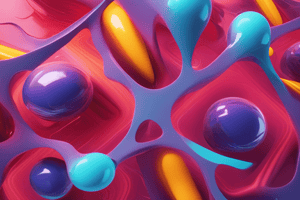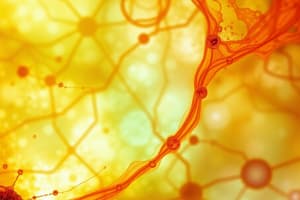Podcast
Questions and Answers
What is the main principle underlying chromatography techniques?
What is the main principle underlying chromatography techniques?
- Differential distribution of mixture components between two phases (correct)
- Usage of only solid stationary phases
- Separation of pigments based on solubility
- Dependence on the color of the compounds
Why was the term 'chromatography' derived?
Why was the term 'chromatography' derived?
- To indicate the use of gas as the mobile phase
- To highlight its usage in separating colored compounds (correct)
- To emphasize the application in organic chemistry
- To separate pigments from compounds
What does TLC stand for in the context of chromatography applications?
What does TLC stand for in the context of chromatography applications?
- Thin Layer Chromatography (correct)
- Total Liquid Chromatography
- Thick Layer Chromatography
- Tandem Layer Chromatography
Which phase can the stationary phase in chromatography be?
Which phase can the stationary phase in chromatography be?
What is the main factor determining the type of chromatographic technique used?
What is the main factor determining the type of chromatographic technique used?
What is the purpose of thin-layer chromatography?
What is the purpose of thin-layer chromatography?
Which technique is thin-layer chromatography considered to be a form of?
Which technique is thin-layer chromatography considered to be a form of?
What are the most frequently used adsorbents in thin-layer chromatography?
What are the most frequently used adsorbents in thin-layer chromatography?
How are commercial TLC plates prepared?
How are commercial TLC plates prepared?
What is the purpose of activating precoated silica gel or alumina TLC sheets before use?
What is the purpose of activating precoated silica gel or alumina TLC sheets before use?
Thin-layer chromatography (TLC) is a form of solid-liquid ______ chromatography
Thin-layer chromatography (TLC) is a form of solid-liquid ______ chromatography
The most frequently used adsorbents in thin-layer chromatography are silica gel (SiO2) and ______ (Al2O3)
The most frequently used adsorbents in thin-layer chromatography are silica gel (SiO2) and ______ (Al2O3)
Silica gel is somewhat ______; usually it effectively separates acidic and neutral compounds that are not too polar
Silica gel is somewhat ______; usually it effectively separates acidic and neutral compounds that are not too polar
Activation usually involves heating the powder to remove some of the adsorbed ______
Activation usually involves heating the powder to remove some of the adsorbed ______
Aluminum oxide is available in acidic, basic, and ______ formulations for the separation of relatively nonpolar compounds
Aluminum oxide is available in acidic, basic, and ______ formulations for the separation of relatively nonpolar compounds
The term chromatography is derived from the fact that this technique was first used to separate ______
The term chromatography is derived from the fact that this technique was first used to separate ______
Whatever the precise experimental procedure, all of the techniques depend on the differential distribution of various components of a mixture between two phases: the ______ phase and the stationary phase
Whatever the precise experimental procedure, all of the techniques depend on the differential distribution of various components of a mixture between two phases: the ______ phase and the stationary phase
The mobile phase may be either a ______ or a gas and the stationary phase either a solid or liquid
The mobile phase may be either a ______ or a gas and the stationary phase either a solid or liquid
The term chromatography is derived from the fact that this technique was first used to separate ______ (Greek: chroma = colour, graphein = write)
The term chromatography is derived from the fact that this technique was first used to separate ______ (Greek: chroma = colour, graphein = write)
Various combinations of these components give the main types of ______ techniques
Various combinations of these components give the main types of ______ techniques
Flashcards are hidden until you start studying
Study Notes
Chromatography Principles
- The main principle underlying chromatography techniques is the differential distribution of various components of a mixture between two phases: the mobile phase and the stationary phase.
Origin of Chromatography
- The term 'chromatography' is derived from the Greek words 'chroma' meaning color and 'graphein' meaning write, as it was first used to separate colored substances.
Thin-Layer Chromatography (TLC)
- TLC stands for Thin-Layer Chromatography in chromatography applications.
- The stationary phase in chromatography can be a solid or a liquid.
- The main factor determining the type of chromatographic technique used is the combination of the mobile phase and stationary phase.
Purpose of Thin-Layer Chromatography
- The purpose of thin-layer chromatography is to separate and identify the components of a mixture.
- Thin-layer chromatography is considered a form of solid-liquid chromatography.
Adsorbents in Thin-Layer Chromatography
- The most frequently used adsorbents in thin-layer chromatography are silica gel (SiO2) and alumina (Al2O3).
- Silica gel is somewhat acidic, effectively separating acidic and neutral compounds that are not too polar.
Preparation of TLC Plates
- Commercial TLC plates are prepared by coating a suitable adsorbent, such as silica gel or alumina, onto a glass or plastic plate.
Activation of Precoated TLC Sheets
- Activating precoated silica gel or alumina TLC sheets before use involves heating the powder to remove some of the adsorbed water.
- Aluminum oxide is available in acidic, basic, and neutral formulations for the separation of relatively nonpolar compounds.
Studying That Suits You
Use AI to generate personalized quizzes and flashcards to suit your learning preferences.




